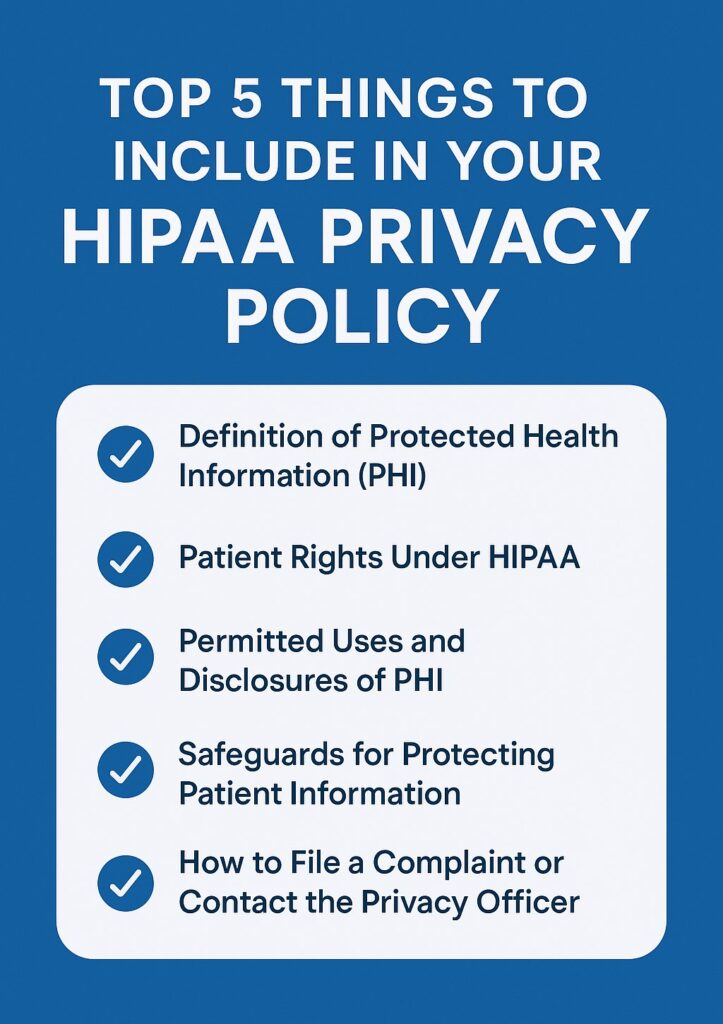Top 5 Things to Include in Your HIPAA Privacy Policy
Healthcare organizations are legally required to protect patient data under the Health Insurance Portability and Accountability Act (HIPAA). One of the most important documents that ensures compliance is the HIPAA Privacy Policy. This policy not only helps organizations stay compliant with federal law but also builds trust with patients by showing a commitment to safeguarding their Protected Health Information (PHI).
If you’re drafting or updating your HIPAA Privacy Policy, here are the top 5 essential elements to include.
1. Definition of Protected Health Information (PHI)
Start by clearly defining what qualifies as PHI under HIPAA. Patients and staff should understand that PHI includes:
-
Medical records and history
-
Billing information
-
Test results and lab reports
-
Any identifiable data like name, address, or Social Security number
By including a clear definition, your policy ensures everyone knows what data is protected and subject to HIPAA rules.
2. Patient Rights Under HIPAA
Your HIPAA Privacy Policy should explain patients’ rights, which include:
-
The right to access their medical records
-
The right to request corrections to their records
-
The right to request restrictions on how their data is used
-
The right to receive a copy of your privacy practices
This empowers patients and demonstrates transparency in how their sensitive data is handled.
3. Permitted Uses and Disclosures of PHI
Not all sharing of patient data is prohibited under HIPAA. Your policy should clarify how PHI can be used and disclosed, such as:
-
For treatment purposes (sharing with other providers)
-
For payment and billing activities
-
For healthcare operations (quality assessments, audits, training)
-
When required by law (e.g., reporting infectious diseases or compliance checks)
Being clear about permitted disclosures helps avoid misunderstandings and legal risks.
4. Safeguards for Protecting Patient Information
Patients want reassurance that their information is secure. Your HIPAA Privacy Policy should outline:
-
Administrative safeguards (employee training, access controls)
-
Physical safeguards (secure facilities, locked filing systems)
-
Technical safeguards (encryption, secure servers, password protection)
These safeguards demonstrate proactive steps your organization takes to prevent breaches and unauthorized access.
5. How to File a Complaint or Contact the Privacy Officer
Your policy should explain the procedure patients can follow if they believe their privacy rights have been violated. Include:
-
Contact details for your HIPAA Privacy Officer
-
Instructions on how to submit a complaint internally
-
Information about filing a complaint directly with the U.S. Department of Health and Human Services (HHS)
This ensures transparency and compliance with HIPAA’s enforcement requirements.
Final Thoughts
A well-written HIPAA Privacy Policy is not just a compliance requirement—it’s a commitment to protecting patient trust. By including these five essential elements—PHI definitions, patient rights, permitted disclosures, safeguards, and complaint procedures—you can create a clear and comprehensive policy.
If you want to go beyond compliance, review and update your HIPAA Privacy Policy regularly. Regulations evolve, and so do security risks. Keeping your policy up to date ensures your organization remains compliant while showing patients that their privacy is a top priority.
